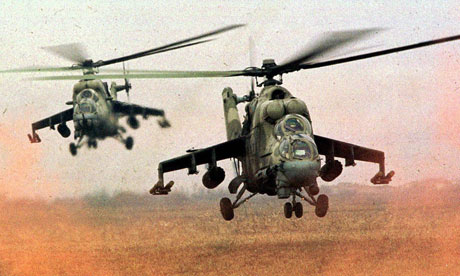Kofin Annan 'appalled' after UN monitors verified use of heavy weaponry in attack believed to have killed more than 140 people
Martin Chulov in Beruit and Matthew Weaver
guardian.co.uk,

Syria used helicopter gunships and other heavy weaponry in the shelling of Tremseh, says General Robert Mood, head of the UN monitoring mission in the country.
The head of the UN monitoring mission in Syria has said that helicopters and tanks were used to shell a town in the centre of the country before a massacre that is believed to have killed more than 140 people on Thursday.
General Robert Mood, who has led the UN presence in Syria since April, said his members were ready to enter the town of Tremseh if a truce there took hold. He said monitors stationed in the area had personally verified that heavy weapons were directed against Tremseh on Thursday.
Late on Friday the UN said observers had been unable to contact the local military commander responsible for the area near Tremseh and its members had been refused access. It claimed the Syrian air force "continued to attack populated urban areas on a large scale" and said its observers had logged more than 100 explosions in an "ongoing military operation".
Residents of the small town of around 6,000 people said they were attacked from outlying areas late on Thursday after many hours of shelling. They blamed the attack on loyalist forces and a pro-regime militia known as the Shabiha which has been accused of being at the vanguard of other mass killings during recent months.
Syrian officials instead blamed "terrorists", who they say have been responsible for much of the violence in Syria since the uprising began almost 17 months ago.
The UN's special envoy to Syria, Kofi Annan, said he was "shocked and appalled" by "intense fighting, significant casualties, and the confirmed use of heavy weaponry such as artillery, tanks and helicopters" in Tremseh, which is in an ethnically mixed area, 22 miles from Hama.
Activists in the area say around 600 casualties are being treated in field clinics and hospitals in surrounding areas. They claim that many bodies remain in crop fields and a final death toll will not be known for days.
It was difficult to obtain first-hand accounts from Tremseh were difficult to obtain on Friday, with communications to the area down and residents unreachable on equipment that had been given to them by activist networks.
Mousab al-Hamadee, an opposition activist living 12 miles away, said people had travelled to the town early on Thursday to warn of an impending regime assault. Hamadee said he had spoken to his sister who said the attack had been relentless. "A big number of the young men were killed in the field when they were trying to escape the army attack," he said. "Helicopters targeted them by heavy machine guns while they were driving their motorcycles – while they were fleeing the village.
"Today the people of Tremseh opened a house that was burned by troops. They found two people who were burned alive. My sister told me that the only two doctors in the village were targeted by mortar shells. Both doctors were killed in their houses."
The massacre took place ahead of a UN security council meeting that is expected to weigh a new response to the crisis in Syria, which has morphed over the past year from a series of anti-regime demonstrations in many towns and cities in Syria into a full-scale insurrection.
Some European states and the US are pushing for the UN to impose sanctions under a Chapter Seven resolution. However, Russia and China, which have staunchly supported Damascus throughout the uprising, have again indicated that they will use their vetoes to block such a move.
Damascus said earlier this week that it is committed to Annan's six-point peace plan and nominated an interlocutor that it said would represent the regime in discussions with the opposition to bring about a ceasefire.
http://samotalis.blogspot.com/
No comments:
Post a Comment